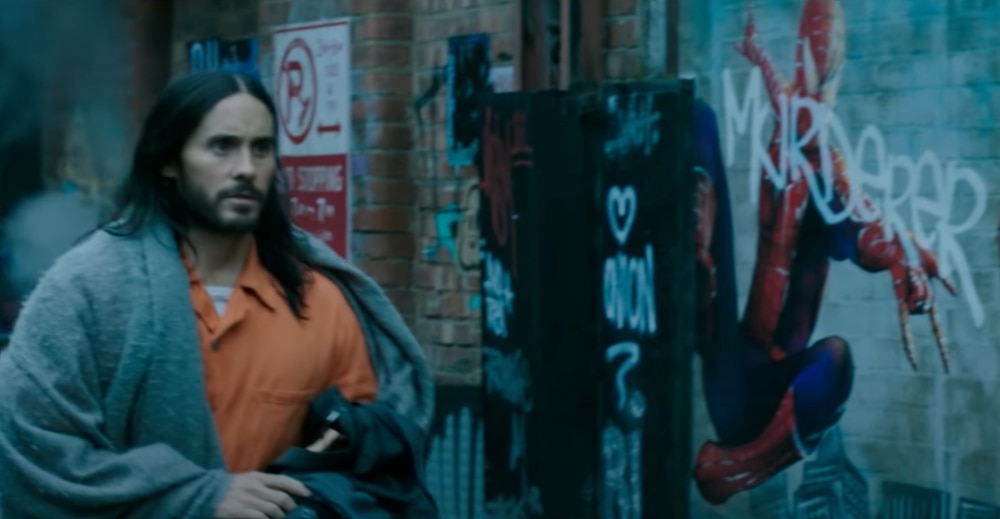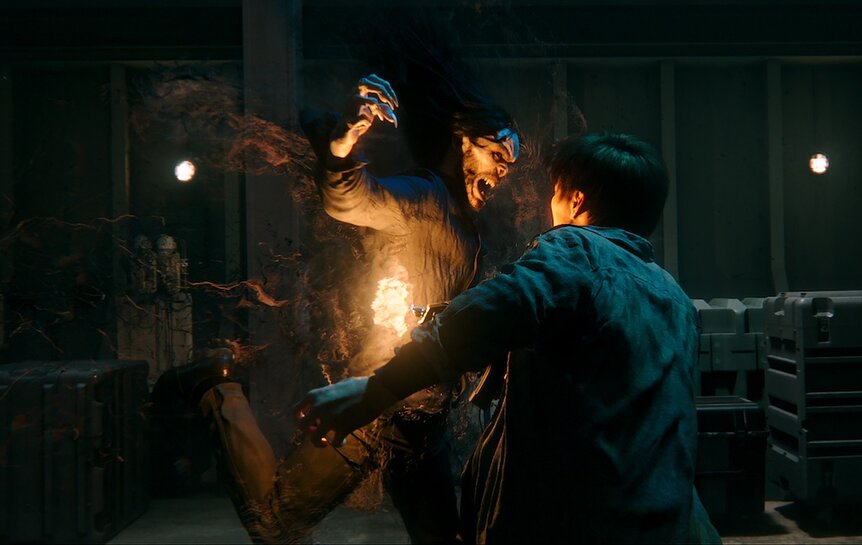Create a free profile to get unlimited access to exclusive videos, sweepstakes, and more!
Why all the Marvel and MCU connections in 'Morbius' are so messy
Morbius the Living Vampire may be a blood-sucker, but Morbius thinks its audience are a bunch of suckers.

Morbius, the new film about Morbius the Living Vampire, really, really wants people to know it’s a Marvel movie.
The tagline for the film is “A New Marvel Legend Arrives.” Trailers had references to Venom, which was to be expected given that those films are also part of Sony’s burgeoning Spider-Man-adjacent cinematic universe. More curious, though, were hints that Morbius might actually have connections to the Marvel Cinematic Universe. A shot from the trailers featured graffiti of Spider-Man with the word “murderer” written on the web-slinger, and Michael Keaton, seemingly reprising his Spider-Man: Homecoming role as the Spidey villain Vulture, appeared in shots.
However, any hopes that Morbius would truly integrate Sony’s Spidey movies and the MCU were for naught, as the connections either don’t exist or are so nakedly misleading and forced as to be insulting.
Warning: The rest of this story contains spoilers for Morbius, but if you’re considering watching Morbius just to see the MCU connections… you can probably just read ahead and skip the movie.
Morbius is essentially a standalone story with no connections to other Marvel properties — MCU or otherwise. The Spider-Man graffiti is straight-up not in the movie, and references to Venom basically boil down to one tossed off reference to events in San Francisco from last year's Venom sequel. The Daily Bugle, Spidey’s newspaper of choice, appears and there are blink-and-you'll-miss-it Easter egg headlines alluding to villains like Black Cat, the Rhino and the Chameleon. Essentially, though, there are no substantive Marvel connections. That is, until the post-credits scenes, when Sony takes back its toys and steals a character from the MCU for the express and ham-fisted purpose of setting up a cinematic universe that nobody (other than studio suits) asked for.
Keaton’s Vulture, a.k.a. Adrian Toomes, only appears in Morbius’ post credit scenes. The first opens with a shot of the New York City skyline and there’s a purple rift in the sky, seemingly created by the spell that Doctor Strange cast in Spider-Man: No Way Home. Then Keaton, whose character was last seen in jail at the end of Homecoming, materializes in an empty jail cell. It’s implied that he has been brought from the MCU to the universe where Morbius takes place. And Toomes is given zero screen time to acknowledge the ramifications of such a move, either. Or if any of that registers at all. News reports explain that he’s released from jail as there’s no record of an “Adrian Toomes” existing in this reality, let alone committing any crimes.
The second post-credit scene has Jared Leto’s Morbius driving out to a remote desert location to meet with Toomes, who has apparently rebuilt his Vulture suit, or took it with him somehow from his original universe. Toomes explains that he does not know how he got here but thinks it has “something to do with Spider-Man,” and then he pitches Morbius on a team-up so they can do some good.
This course of events doesn’t make sense if you think about the fictional logic of these movies. Why would Toomes have been pulled from his home universe of the MCU if Doctor Strange’s spell didn’t affect anybody else that way? How did he rebuild the Vulture suit without his MCU resources or the Tinkerer’s knowhow? Why doesn’t he seem to care about the family he left behind in the MCU? Does Spider-Man even exist in this universe?
But, of course, the story explanations and plot holes don’t really matter as this moment is in the service of two more important goals: 1) Set up a Sinister Six movie so that Sony can pad out its “(Everything But Spider-Man) Spider-Man Cinematic Universe” and 2) Get fans who are excited about shared universe teases to buy a ticket for the film Morbius.
The fact that every story about blockbuster superhero movies needs to include a paragraph explaining corporate deals and the legal status of rights to various characters remains a wild feature of the modern entertainment landscape, but to recap: Sony owns the film rights to Spider-Man and all the Spidey villains and side-characters. Disney-owned Marvel Studios has the film rights to basically everyone else.
The two companies cut a deal where Sony lends Spider-Man, as played by Tom Holland, to the MCU. Given how much money No Way Home made, it seems like a pretty good partnership. But, of course Sony would like to take advantage of their Spider-Man ownership in a way that doesn’t require sharing with their frenemy Marvel Studios. That's their right, and that’s why we’re getting movies like Venom, Morbius, and upcoming flicks like Kraven the Hunter.
The problem is with the possible exception of Venom, who has always been a very popular character, it’s unclear that anybody is really excited to see movies about Spider-Man villains or side characters that don’t feature, you know, Spider-Man.
I’m sure there are Morbius fans out there, but despite what the tagline says, my guy is not “The Next Marvel Legend.” And so, Sony’s building hype for Morbius and whatever this cinematic universe ends up being by feinting at connections to an established, more popular franchise.
Instead of being a good movie on its own merits, Morbius misleads fans into thinking it’s something it’s not, and then tries to exploit a tenuous connection to gin up excitement about what comes next. Morbius the Living Vampire may be a blood-sucker, but Morbius thinks its audience are a bunch of suckers.



























